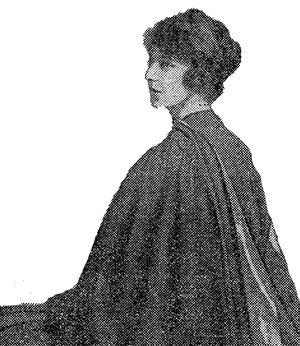A LEGAL FIRST
By Sarah Spence
Madge Easton Anderson might not be a name you’ve heard before, but she holds a special place in legal history.
It was only 100 years ago, in 1919, that the Sex Disqualification (Removal) Act allowed women to enter the legal profession. And a young woman from Glasgow, Madge Easton Anderson, was poised to take full advantage of this changing professional landscape, becoming the first woman admitted to practise as a solicitor in Scotland and the first female lawyer in the UK.
Madge graduated from the University with an MA(Ord) in 1916, a BL in 1919 and an LLB in 1920, winning a variety of prizes in law along the way. She joined Glasgow law firm Maclay Murray & Spens LLP as an apprentice law agent in 1917.
This was a year before the 1918 Representation of the People Act passed, allowing women (at least those over 30 who met a property qualification) to vote for the first time in the UK. It would be a further three years before the first female jurors in Scotland were sworn in at Edinburgh Sheriff Court in 1921.
Overcoming barriers
Women had been fighting for decades to enter public and professional life, often facing discrimination and resistance. The first female undergraduates in Britain, studying medicine at the University of Edinburgh from 1869, were charged higher fees, made to take separate classes and harassed by male students and teachers. This culminated in the 1870 Surgeons’ Hall Riot, when the group was verbally abused and pelted with refuse on their way to an exam.
Women’s entry into studying law came slightly later. Eliza Orme was the first woman law graduate in England in 1888, with Eveline MacLaren and Josephine Gordon Stuart the first in Scotland in 1909. Yet, until the 1919 Act, women couldn’t enter the legal profession.
Madge faced her own obstacles. Her application for admission as a law agent in 1920 was refused because her apprenticeship had begun before the 1919 Act came into force. However, she successfully appealed to the Court of Session, Scotland’s highest civil court, allowing her to sit the final Law Agent exam. She passed and was admitted in late 1920.
A life in law
In 1922 Madge was working for Glasgow law firm John Steuart & Gillies, remaining there for five years before setting up practice on her own in the Glasgow suburb of Giffnock.
She later moved to London with her mother and aunt and became the first woman qualified to practise as a solicitor in both Scotland and England, after passing the final examination of the English Law Society in 1937. She was a partner in the first UK law firm with an all-female leadership, working with Edith Annie Berthen and Beatrice Honour Davy in London until the partnership was dissolved in 1951.
Madge moved back to Scotland, settling in Perthshire until her death in 1982.
Centenary celebrations
The University’s School of Law is celebrating the centenary of the Sex Disqualification (Removal) Act and the achievements of women in law with the '100 Voices for 100 Years' project. Led by senior lecturer Maria Fletcher, the project brings together stories of 100 women connected to the school.
Seonaid Stevenson is a research assistant on the project and, like Madge, is a graduate of the school and trained at the firm where Madge herself was an apprentice. The majority of Seonaid’s classmates were women and she is surrounded by positive female role models in her professional life. “I often think about how different Madge’s experiences as a young woman in law were compared to my own journey,” says Seonaid. “I am grateful to the pioneers like Madge who blazed a trail so that young women like me could have a seat at the table.”
What strikes Seonaid most about Madge is that “she clearly cared about her community and the vulnerable people within it”. From 1920 to 1930, Madge acted as a “Poor Man’s Lawyer” through the University’s Settlement organisation, providing free legal advice to those in Glasgow’s Anderston community unable to pay.
Supporting vulnerable people is what motivates Seonaid today. With two other trainees, she formed an organisation called RebLaw Scotland which seeks to use law as a tool for social justice. “We like to think that Madge would have been proud that 100 years later, women continue to use law to help those around us.”
The fight for equality and diversity in the legal profession isn’t over. Seonaid highlights that one of the key issues for women today is progression, rather than access. But by celebrating trailblazers like Madge Easton Anderson, her legacy continues to inspire the next generation of equality advocates.
This article was first published in September 2019.
Photo: Daily Record 16 December 1920. Courtesy of The Mitchell Library, Glasgow.
WORLD CHANGING ALUMNI AWARD
This is a prestigious annual University honour which recognises and celebrates the achievements of alumni who have made a major contribution to the community, arts, science or business. It has been presented to a world-changing alumnus every year since 2001.


